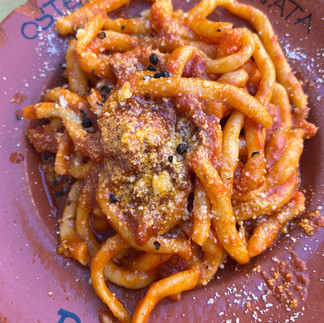Rome is always a good idea: whether you are passionate about culture, art, history or food, a weekend in Rome is always the right choice! We are those who love to return to Rome often mainly for its delicious cuisine: we could live on tonnarelli cacio e pepe and pinsa, every day, forever. We know that in Rome, wherever you eat, everything is always incredibly good and even though I try to try some new place every time, for better or worse there are some unmissable places that I love to return to, sure of not making mistakes! We are firmly convinced that the best cuisine in Rome is concentrated in Trastevere... most of our favorite places are located in this splendid neighborhood, incredibly welcoming, traditional and full of culinary possibilities. And if Trastevere is our favorite destination for dinner, you won't go wrong for an aperitif at Campo dei Fiori! But beyond Trastevere, in every corner of Rome, there is a restaurant or tavern to try... this is one of the magic of the capital! After having discovered together what to do and what to see in the capital, let's now discover some of our favorite dishes and places, all tested firsthand (and for better or worse as updated as possible) with our personal opinions!
Typical dishes of the Roman tradition
Let's start with the traditional and unmissable dishes of Roman and Italian cuisine, from first to second courses and finally desserts - everything you absolutely must try on a weekend in Rome!
- Supplì
The supplì are delicious rice croquettes with meat sauce with crunchy breading on the outside and a stringy heart of mozzarella; absolutely irresistible and tasty as a starter or at happy hour to go with a nice glass of wine. They owe their name to their mozzarella: a French soldier stationed in Rome at the beginning of the 19th century and he didn't expect the stringy cheese inside and called that delight a surprise (a "surprise", Italianized into supplì directly from the French).
- Spaghetti alla carbonara
The carbonara recipe is a true creed for every self-respecting Roman: eggs, bacon and pecorino romano - absolutely avoid bacon and any kind of sauté with onion or garlic. Usually, the best pasta for a good carbonara is spaghetti or tonnarelli.
- Bucatini all'amatriciana
Great Roman classic, one of my favorite dishes: amatriciana as it should be prepared with bucatini, San Marzano tomatoes, Amatrice bacon and pecorino romano DOP. The history of amatriciana is closely linked to that of its ancestor, "alla gricia" pasta, with which it shares the same ingredients except the tomato. The gricia was in fact born in the area between Lazio and Abruzzo, in villages such as Amatrice; the recipe was updated with the addition of tomato, becoming the current amatriciana which was then brought to Rome by shepherds during transhumance and by many innkeepers originating from the city of Amatrice. In this way the word 'matriciano became synonymous with "restaurateur", and hence the name amatriciana.
- Tonnarello cacio e pepe
Tonnarelli is an egg pasta that resembles spaghetti but much thicker and porous, which is why it is perfect for cacio e pepe: the creaminess of the pecorino is deliciously soaked into the tonnarelli. The history of this recipe is connected to the transhumance of shepherds between Lazio, Umbria and Abruzzo, who, constantly moving with their flocks, needed easily available and even easier cooking ingredients.
- Abbacchio scottadito
Also called "Roman-style" lamb, it is an Easter recipe which however is cooked all year round in Rome's restaurants. The basic ingredient is the meat of suckling lamb, which is very common in Lazio and is called abbacchio. Therefore it is marinated lamb chops, greased with lard and cooked on the grill, and should be eaten piping hot so as not to lose the tenderness of the meat. In fact, the name comes from the fact that the ribs are eaten with the hands while they are still hot, often burning the fingers.
- Coda alla vaccinara
Coda alla vaccinara is a 100% Roman specialty that usually has four fundamental ingredients: oxtail, tomato sauce, bitter cacamo and celery. Thanks to the long cooking, the tail meat comes away from the bone, melting in the mouth, while the sauce that accompanies it is perfect for making a slipper with bread! Every self-respecting trattoria has its own version of the vaccinia tail but the original recipe was developed in the Regola district, a popular neighborhood where the vaccinia lived, that is, the workers who worked with the cattle in the Roman slaughterhouse.
- Saltimbocca alla Romana
Roman saltimbocca are simple slices of veal cooked in butter and rolled on a heart of ham and a sage leaf held together with the classic toothpick.
- Carciofi alla giudia
Artichokes alla giudìa are a dish originating from the Jewish ghetto of Rome but have now become a great classic of Rome. Artichokes are marinated and then removed from the outer leaves and then fried in olive oil. For this recipe, Roman chefs rigorously use violets (cimaroli artichokes, without thorns and round in shape). The origin of Giudia artichokes is evidently Jewish (in fact "giudìo" in Roman jargon means Jew) and was brought to Rome by the Jews expelled from Spain.
- Pinsa
Pinsa comes from the Latin “Pinsere” which in Italian means to stretch – to spread; what we eat today in Rome is a revisitation of the ancient recipe that dates back to the time of Ancient Rome, reworked thanks to today's ingredients and processing techniques. The recipe as an original idea takes shape from an ancient product that came from the peasant populations outside the walls, who, thanks to the grinding of cereals (millet, barley and spelled) and with the addition of salt and aromatic herbs, cooked these flatbreads or focaccias elongated. The term Pinsa derives from the Latin Pinsere: to stretch-crush. This classic recipe has undergone several revisitations over the centuries, up to the present day. Compared to the classic pizza dough, Roman pinsa provides a different quantity of water and a lower percentage of yeast, thus obtaining a more digestible and less caloric preparation.
- Maritozzo
Maritozzo is a fragrant brioche filled with cream: specifically it is a sweet bread that in Roman times was given to the future wife by the man, the "maritozzo", who had to insert a ring or other decorative object inside. gold as a token of love. If you want to have a typical Roman breakfast then it must necessarily be with a maritozzo!
- Grattachecca
To start and avoid an injustice to the centuries-old tradition of Grattachecca, let's point out that it is not a granita!!! ...they just look alike! It is ice scraped from a sheet with a special tool with which a glass is then filled and then seasoned with every type of syrup possible together with pieces of fresh fruit. There are those who say that the name "grattachecca" derives from a lady, one Francesca, who used to scratch ice. To exhort her, the people around her used to say “scratch it, Checca”. Checca was actually the diminutive of Francesca.
Where to eat in Rome
Now that we discovered the timeless classics of Roman cuisine, let's find out together where to find them in the capital and start to taste them all!
Vineria di Roma - Trapizzino

Our culinary tour of Rome (basically one of the main reasons why we often go back to the capital) begins with an inevitable stop in one of our favorite places, the Vineria di Roma, to taste its famous and succulent Trapizzino. The Trapizzino is a corner of pizza stuffed with typical Italian and Roman recipes invented about ten years ago by Stefano Callegari. It is a pocket of white pizza closed at the sides and made with a dough of soft wheat flour and yeast. It is a Roman street food to be enjoyed sitting at the tables of the restaurant or like us, walking along the alleys of Trastevere, looking for a place to have dinner. We tried Trapizzino for the first time last year, and this year too we couldn't miss it: while we were driving towards Rome we talked about the moment when we would try this delicious food again!

Like the first time, I suggested Enrico take just one to share, but obviously he didn't listen to me: this year I went back to my classic trapizzino alla Parmigiana, while Enrico tried courgettes and stracciatella (last year had chosen the one at Coda alla Vaccinara). Obviously, like almost all the timeless classics of Roman cuisine, the Trapizzino is absolutely neither small nor light, but certainly delicious: the dough is exceptional, and the filling is super abundant and tasty, whatever you decide to put in it: certainly with the parmigiana and vaccinia you won't go wrong! Price (updated July 2023): €5 for Trapizzino
The other specialty of the Vineria di Roma (which you can now also find in Milan and Turin) is the Supplì: there are many varieties and very special flavors, such as matriciana, cacio e pepe or gricia.
Tonnarello - Locanda dal 1876
In the heart of Trastevere, one of our favorite restaurants is definitely Tonnarello, where we use to go back every time we are in Rome. The historic tavern is in Via Paglia, but there is also another restaurant with the same name and with the same owners a few hundred meters away, in Via della Scala, also in Trastevere. Fortunately, few people still know about the second location! While in the historic one, there are hundreds of meters of queues, in the new one the process is always much quicker. This year too, in a quarter of an hour of waiting - just the time for a quick trapizzino - we managed to have a nice table for two and taste their specialty: obviously the tonnarelli!

Both restaurants are gigantic, with lots of tables both outside and inside, and fortunately very efficient staff, given that they are always crowded with both locals and tourists. Because of Tonnarello's fame, if you want to eat here you'll have to be smart: they don't accept reservations and the queue is always endless, so if you don't want to wait for hours you'd better come early towards the opening hours and choose the new location. Tonnarelli is their specialty but they have many specialties of Roman cuisine, including pinsa. The best are obviously the timeless cacio e pepe, grigio, amatriciana or carbonara! The portions are immense, keep this in mind when you order: this year we were a little more limited, fortunately, ordering only one (infinite) plate of pasta each, but last year we also had a pinsa and I have no idea how we could have finished it all! Compared to last year the prices have increased by around €2 per dish but the quality remains excellent making it still worth it, and given the queue that is always there I think I'm not the only one who thinks so! Price: tonnarello cacio e pepe, tonnarello alla carbonara, a 1 liter still water and a medium beer €39.
Nannarella
Nannarella is another Trastevere tavern sister to Tonnarello: same menu, same prices, same quality and style. An extra chance to try the delicious traditional Roman dishes offered by Tonnarello. Like the cuisine, the fame and consequently the queue to get a table are the same that you will find at Tonnarello, so arm yourself with a lot of patience and try your luck in one of the 3 restaurants that seems to have less waiting!
Osteria da Fortunata

The very famous Osteria da Fortunata had inspired me for quite a while, so we had to go there by force, even though it was definitely off our itinerary ... but it was absolutely worth it! The place is very close to Campo dei Fiori, and it's a nice place, with the sfogline that roll the pasta in front of the window. There is always a very long line to sit at the table, so the same rule applies to Tonnarello: get there early or you will even wait for hours. For me the usual Amatriciana, I must say perhaps the best I have ever eaten, while for Enrico a Carbonara, also very good. The prices are higher than those you will find in Trastevere, we spent € 35 for two pasta dishes and still water, but it was totally worth it! Highly recommended!

But let's talk about Pinsa now: for me, the best in the city you will find in this very small takeaway place: Pinsa 'mpò, just outside the Vatican walls. From the outside it looks like a simple pizzeria, a bit anonymous and the same as many others... but guys, hear me out: you must definitely try it out! It's a little place that we discovered last year and this year we went back on our first evening in the city... the weeks before going back to Rome I dreamed of this Pinsa at night! The place is basically for takeaway, it has some seats at the counter inside, and a few tables outside for the summer. Don't worry about the place and listen to me: go there and try all the flavors! This time we limited ourselves to 3 pinsas for two: one alla norma, one carbonara and one sausage and potatoes; last year we took 4 but two were really too many! We also recommend the amatriciana one, delicious! The Roman classics are always there, but in reality the menu changes often, they use many seasonal ingredients, so there is always something new to discover! Excellent value for money: three pinsas and three canned cokes cost us €22

Rifugio Romano is our latest discovery: this weekend in Rome was the first as a vegetarian and I was curious to try some dishes from the Roman culinary tradition in a vegan way... my favorite Roman dish has always been amatriciana and I was hoping to eat some of it one again this year. After various searches I came across Rifugio Romano, a restaurant specializing in Roman cuisine with a veg twist, so obviously we had to try it... and I'll tell you that we were definitely amazed and satisfied! The place is nice but small, so if you want to try it I highly recommend you book a few days in advance - Rifugio Romano reservations! We went for lunch and tried two small appetizers: a supplì and an arancino, then for Enrico a cacio e pepe while for me obviously an amatriciana, all in a vegan way! The dishes were delicious and the portions very generous with an excellent quality-price ratio: we spent €42.50 including 1l still water and a medium beer. Definitely recommended!
Tiramisù Trastevere

Another exceptional discovery of this Roman weekend 2023 was Tiramisù Trastevere... that's right, you understood correctly: a place specializing exclusively in Tiramisu, a real daydream. You can choose the traditional format in two different sizes - small (5€) or large (6€) - or you can vary your tiramisu in other flavors (for a 50-cent surcharge) including caramel, amaretto, rocher, berries, Oreo and Nutella or Pan di Stelle with Nutella, since the tiramisu is made on the spot in front of you.

Furthermore, you can choose a Tiramisu with decaffeinated coffee or the following version:
gluten-free
lactose-free
vegan
The possibilities that this place offers are endless and in my opinion the concept is truly brilliant; we passed by by chance just as we were complaining about how full we were and how we had exaggerated at dinner at Tonnarello... but once we saw this place we couldn't give it up and tried a cup of it with caramel ripple! Spectacular!!
Alla Fonte d'Oro - Grattachecca
This year we had the brilliant idea of going to Rome in the middle of July and we literally almost died: it was so damn hot! If we survived it was only thanks to constantly eating the delicious Grattachecca. At Fonte d'Oro, on the Tiber, the Grattachecca has been a serious thing for generations: it is in fact one of the most famous and oldest kiosks in the city... if you are looking for the real Grattachecca you won't go wrong here!
Pasticceria Parenti
At Pasticceria Parenti we have always had breakfast: it's a little place located near our hotel where we have always found plenty of choice with lots of delicious sweets, on the way to the Vatican.
Pasticceria 5 Lune
The 5 Lune Pastry Shop is located near Campo dei Fiori, about ten meters from the Osteria da Fortunata in fact, we went there to finish our lunch with a sweet treat. It's a family-run pastry shop, very friendly, with a huge variety of delicacies. Whatever you choose will not disappoint you.
If you are planning your weekend in Rome and you're still in doubt about what to do, then don't miss my article with all the best that Rome has to offer and some ideas for a 3-day itinerary! READ ALSO: 3 days in Rome, the Eternal City - itinerary, museums, and everything you have to see If you are still in the planning phase and need some advice then READ ALSO: Everything you need to know on how to plan a trip to Rome If you have more than a couple of days available for your holiday, then you might consider going outside of Rome and exploring some other wonders in Lazio such as the splendid village of Civita di Bagnoregio or the Parco dei Mostri of Viterbo. READ ALSO: One day trip in Viterbo: Bomarzo's Park of the Monsters and Civita di Bagnoregio
If you know other special places to eat in Rome, don't hesitate and write me down in the comments, so on my next Roman trip I can try something new!
For any doubts or other information do not hesitate to write to me!
In the meantime, have a good trip and bon appetit!






































Comments